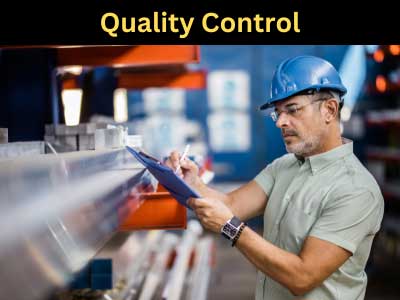Key Takeaway
Quality control (QC) ensures products meet set standards and specifications. The first step in QC is setting quality standards, which define the criteria products must meet. This involves outlining specifications, tolerances, and acceptable quality levels.
The second step is quality inspections and audits. This involves examining products at various stages of production to ensure they meet the set standards. Inspections can be visual or involve testing with specific tools and equipment.
Next, analyzing and reporting is crucial. Data from inspections are analyzed to identify trends, issues, or areas needing improvement. Detailed reports are created to document findings and actions taken.
Finally, continuous improvement is essential in QC. Based on the analysis, processes are adjusted to prevent future defects and enhance product quality. This ongoing process ensures that products consistently meet or exceed quality standards, leading to higher customer satisfaction.
Defining the Quality Control Process
Quality control (QC) in manufacturing refers to the process of ensuring that products meet established quality standards. It involves various methods, including inspections, testing, and monitoring to ensure products conform to the required specifications. This process starts with identifying the necessary quality benchmarks for a product and then establishing a plan to meet them. QC helps in maintaining consistency and reducing defects, ensuring the final product meets both regulatory requirements and customer expectations. By having a defined QC process, manufacturers can avoid costly errors and minimize the risk of producing faulty products. Quality control plays a key role in customer satisfaction, as well as maintaining a company’s reputation.

Establishing Quality Standards for Products
Establishing clear and measurable quality standards is one of the most important steps in the QC process. These standards define the specific requirements that a product must meet in order to be deemed acceptable. In industries like automotive or electronics, these standards could include tolerances in measurements, material specifications, and functionality. Once these standards are set, they serve as a guideline for the entire production process. It helps every department in the manufacturing chain to understand what is expected in terms of quality, ensuring that everyone works towards the same goal. This step also involves collaboration with customers and regulatory bodies to ensure compliance with all applicable requirements. Once these standards are documented, they become the benchmark for conducting inspections and quality checks throughout the production cycle. Regularly updating these standards as technology and customer needs evolve is also critical for staying competitive.
Conducting Inspections and Testing for Quality
Inspections and testing are integral to the quality control process. Inspections ensure that raw materials, work-in-progress items, and finished products all meet the established quality standards. These can be manual inspections, where a trained individual evaluates the product, or automated processes using cameras, sensors, and other equipment to detect flaws. Testing often complements inspections by measuring specific aspects of the product, such as durability, functionality, and safety. For example, stress tests may be conducted to ensure that products can withstand the pressures they will face in their real-world applications. Testing is typically done at various stages of production to identify any potential problems early, allowing for quick corrections before the product is finalized. This ensures that only products that meet the company’s quality standards reach the customer, thus reducing recalls, rework, and waste.
Addressing Non-Conformities in Quality Control
Addressing non-conformities is a critical aspect of quality control. Non-conformities occur when a product or component does not meet the pre-established quality standards. These issues can arise from various factors, including human error, machine malfunction, or material defects. When a non-conformity is identified, it is essential to conduct a root cause analysis to determine what led to the defect. Once the cause is identified, corrective actions are taken to resolve the issue and prevent future occurrences. This may involve retraining employees, adjusting machinery, or altering the manufacturing process. Addressing non-conformities promptly is important because it ensures that defective products do not reach the market, thereby protecting the brand’s reputation and reducing the costs associated with returns, rework, or recalls. Preventive measures, such as updating procedures or enhancing quality checks, also help in minimizing non-conformities.
Continuous Monitoring and Feedback in QC Conclusion: Achieving Excellence Through Quality Control Steps
Continuous monitoring is vital for maintaining high-quality production standards. Unlike periodic inspections, continuous monitoring involves the real-time tracking of production processes. Technologies such as sensors, data analytics, and automated systems help collect and analyze data throughout the manufacturing cycle. These tools enable companies to detect and correct issues as soon as they arise, before they can lead to significant quality problems. Feedback loops are equally important in this phase. Feedback from the production team, customers, and stakeholders helps in improving quality control processes. Regular reviews of this data help to refine operations and identify areas for improvement. By implementing continuous monitoring and feedback, manufacturers can optimize their processes, reduce waste, and ensure that quality standards are consistently met.
Conclusion
Achieving excellence in quality control requires a well-defined process that ensures every product meets high standards. It begins with setting clear, measurable quality benchmarks, followed by conducting regular inspections and tests at each stage of production. This proactive approach allows manufacturers to identify potential defects early and take corrective actions when necessary. Addressing non-conformities promptly helps prevent defective products from reaching customers, safeguarding both the product’s integrity and the brand’s reputation.
Incorporating continuous monitoring and feedback loops further enhances quality control by providing real-time data to identify deviations and optimize processes. This ensures ongoing improvement in production efficiency and product consistency. Ultimately, a comprehensive QC strategy leads to superior products, satisfied customers, and long-term success in competitive markets.
